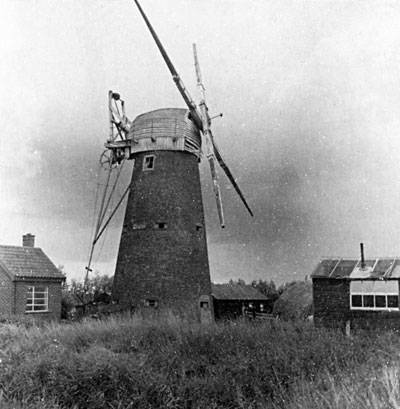
1950
|
Halvergate
Stracey Arms drainage pump River Bure |
 |
1950 |
Stracey Arms drainage pump was built beside the road that became the A47 trunk road and was designed to drain the marshes into the River Bure. The now slightly leaning 4 storey red brick tower had a Norfolk boat shaped cap with a petticoat. Power to the internal turbine pump that replaced the original scoop wheel, was supplied by four patent sails via a cast iron upright shaft and the cap was turned to wind by a white & red striped 8 bladed fantail with a Y wheel and a tailpole. When built, the tower rested on 40ft wooden piles and a pitch pine raft.
In the mills earlier days it was known as Arnup's Mill. Mill is Grade ll listed. |
During World War II the tower was converted to a pillbox complete with gun ports. |
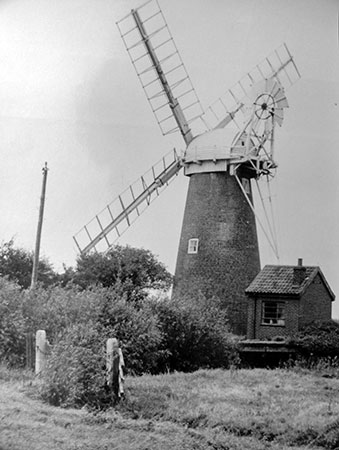 |
c.1964 |
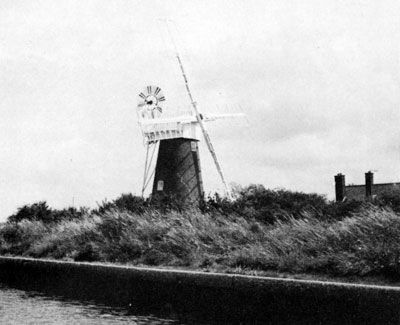 |
July 1985 |
The site was eventually taken over by The Windmills Trust and the mill was restored. The adjacent mill house was set out with a photographic display of depicting the history of Norfolk's drainage pumps. |
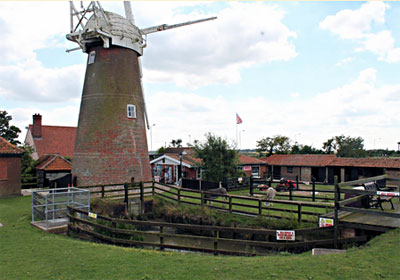 |
2014 |
In 2014 the mill was advertised along with the mill house sale, the mill being owned, insured and maintained by The Windmill Trust. The mill house owners to be paid by the WT to open the mill to the public between Easter and September from 09.00 to 20.00hrs.. |
Work has begun to restore and preserve a mill first built in the 1880s as efforts to use the site as an educational resource take shape. The Stracey Arms Mill, near Great Yarmouth, is to be safeguarded after Norfolk County Council successfully bid for £554,600 from the Heritage Lottery Fund to carry out the work. Once completed, a programme of workshops, day schools and community events will begin at the Grade II listed mill in 2019 for people to learn more about the landmark, the local landscape and the families who lived at the site and worked on the surrounding marshes. Councillor Martin Wilby, chairman of the council's environment, development and transport committee, and also chair of the Norfolk Windmills Trust, said: "This is a fantastic project that will allow people to better understand the history of Norfolk and its historic marshes and distinctive Broads. "I am pleased it was made possible by our bid to the Heritage Lottery Fund." The work, which forms part of the £670,152 Mill and Marsh Folk project, started with the removal of the old cap and sail stocks, which have been taken to the millwright's workshop to be assessed. Any sound timbers salvaged will be reused in the new cap. Robyn Llewellyn, head of East England Heritage Lottery Fund, said: "Thanks to National Lottery players, work is now well under way. "This is an exciting moment in the restoration of such an important building from Norfolk's agricultural past and the start of a great new future." The first phase of work includes brickwork repairs, removal of internal render and the reinstatement of one of the Second World War gun loops, as well as repairs to doors and windows. The mill was built for Sir Henry Stracey of Rackheath Hall by millwright and engineer Richard Barnes of Southtown Ironworks in 1883 to replace an earlier mill on the site. It was intended to drain water off the surrounding marshes and into the River Bure, but was last used in the 1940s, serving as a fortified pillbox during the Second World War with gun loops cut into the tower to defend the local area. Major repairs were carried out in the 1960s before it became the second mill to be gifted to Norfolk County Council. The work is being led by conservation builders R and J Hogg Ltd of Coney Weston, while local millwright Richard Seago will also carry out work on new stocks and sails, as well as repairs to the turbine pump. |
Water pumping controlled by an electric pump in an adjacent brick shed. |
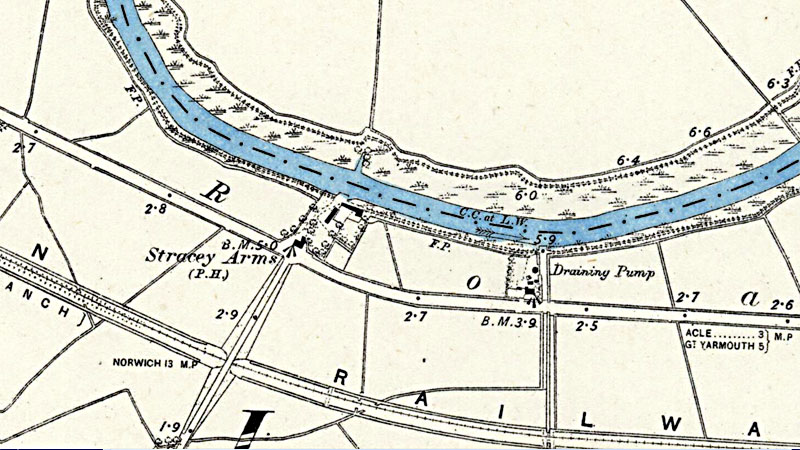 |
O.S. Map 1884 Courtesy of NLS map images |
1883: Mill built for Sir Henry Stracey of Rackheath Hall by Robert Barnes of Gt Yarmouth replacing older mill 1883: Arnup family managed the mill 1912: Mill extensively renovated 1939-45: Mill used as fortified pillbox during second world war c.1941: Arnup family, managing mill 1945: Fred Mutton 1946: Fred Mutton 1946: Mill ceased working and sail shutters removed 1961: Restoration began by Smithdales on behalf of the Norfolk Windmills Trust 1965: Lady Stracey presented the mill to Norfolk CC to be cared for by the Norfolk Windmills Trust 1972: Sails damaged in a gale 2010: One stock missing skeleton sail October 2014: Mill & mill house advertised for sale for c.£625,000 2010: One stock missing skeleton sail 2015: Mill intact but without sails October 2018: Restoration work begun after successful bid for £554,600 lottery grant |
If you have any memories, anecdotes or photos please let us know and we may be able to use them to update the site. By all means telephone 07836 675369 or
|
| Nat Grid Ref TG 44160896 |
Copyright © Jonathan Neville 2014 |